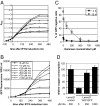Tuning Escherichia coli for membrane protein overexpression
- PMID: 18796603
- PMCID: PMC2567230
- DOI: 10.1073/pnas.0804090105
Tuning Escherichia coli for membrane protein overexpression
Abstract
A simple generic method for optimizing membrane protein overexpression in Escherichia coli is still lacking. We have studied the physiological response of the widely used "Walker strains" C41(DE3) and C43(DE3), which are derived from BL21(DE3), to membrane protein overexpression. For unknown reasons, overexpression of many membrane proteins in these strains is hardly toxic, often resulting in high overexpression yields. By using a combination of physiological, proteomic, and genetic techniques we have shown that mutations in the lacUV5 promoter governing expression of T7 RNA polymerase are key to the improved membrane protein overexpression characteristics of the Walker strains. Based on this observation, we have engineered a derivative strain of E. coli BL21(DE3), termed Lemo21(DE3), in which the activity of the T7 RNA polymerase can be precisely controlled by its natural inhibitor T7 lysozyme (T7Lys). Lemo21(DE3) is tunable for membrane protein overexpression and conveniently allows optimizing overexpression of any given membrane protein by using only a single strain rather than a multitude of different strains. The generality and simplicity of our approach make it ideal for high-throughput applications.
Conflict of interest statement
Conflict of interest statement: S.W. and J.-W.d.G. are cofounders of the biotech company Xbrane Bioscience AB.
Figures






References
-
- Wagner S, Bader ML, Drew D, de Gier JW. Rationalizing membrane protein overexpression. Trends Biotechnol. 2006;24:364–371. - PubMed
-
- Drew D, Fröderberg L, Baars L, de Gier JW. Assembly and overexpression of membrane proteins in Escherichia coli. Biochim Biophys Acta. 2003;1610:3–10. - PubMed
-
- Studier FW, Rosenberg AH, Dunn JJ, Dubendorff JW. Use of T7 RNA polymerase to direct expression of cloned genes. Methods Enzymol. 1990;185:60–89. - PubMed
-
- Arditti RR, Scaife JG, Beckwith JR. The nature of mutants in the lac promoter region. J Mol Biol. 1968;38:421–426. - PubMed
Publication types
MeSH terms
Substances
LinkOut - more resources
Full Text Sources
Other Literature Sources

